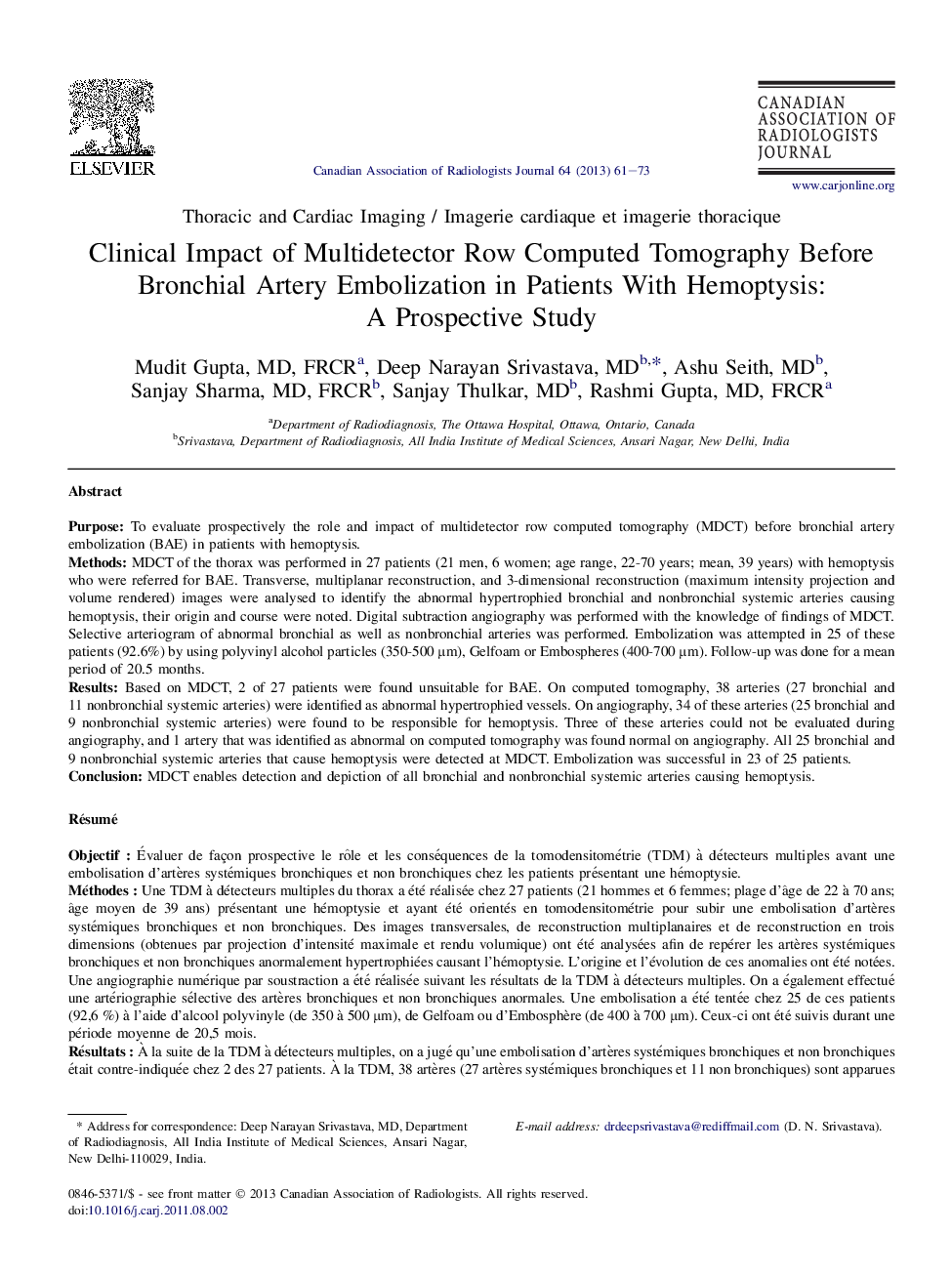| Article ID | Journal | Published Year | Pages | File Type |
|---|---|---|---|---|
| 4220721 | Canadian Association of Radiologists Journal | 2013 | 13 Pages |
PurposeTo evaluate prospectively the role and impact of multidetector row computed tomography (MDCT) before bronchial artery embolization (BAE) in patients with hemoptysis.MethodsMDCT of the thorax was performed in 27 patients (21 men, 6 women; age range, 22-70 years; mean, 39 years) with hemoptysis who were referred for BAE. Transverse, multiplanar reconstruction, and 3-dimensional reconstruction (maximum intensity projection and volume rendered) images were analysed to identify the abnormal hypertrophied bronchial and nonbronchial systemic arteries causing hemoptysis, their origin and course were noted. Digital subtraction angiography was performed with the knowledge of findings of MDCT. Selective arteriogram of abnormal bronchial as well as nonbronchial arteries was performed. Embolization was attempted in 25 of these patients (92.6%) by using polyvinyl alcohol particles (350-500 μm), Gelfoam or Embospheres (400-700 μm). Follow-up was done for a mean period of 20.5 months.ResultsBased on MDCT, 2 of 27 patients were found unsuitable for BAE. On computed tomography, 38 arteries (27 bronchial and 11 nonbronchial systemic arteries) were identified as abnormal hypertrophied vessels. On angiography, 34 of these arteries (25 bronchial and 9 nonbronchial systemic arteries) were found to be responsible for hemoptysis. Three of these arteries could not be evaluated during angiography, and 1 artery that was identified as abnormal on computed tomography was found normal on angiography. All 25 bronchial and 9 nonbronchial systemic arteries that cause hemoptysis were detected at MDCT. Embolization was successful in 23 of 25 patients.ConclusionMDCT enables detection and depiction of all bronchial and nonbronchial systemic arteries causing hemoptysis.
RésuméObjectifÉvaluer de façon prospective le rôle et les conséquences de la tomodensitométrie (TDM) à détecteurs multiples avant une embolisation d’artères systémiques bronchiques et non bronchiques chez les patients présentant une hémoptysie.MéthodesUne TDM à détecteurs multiples du thorax a été réalisée chez 27 patients (21 hommes et 6 femmes; plage d’âge de 22 à 70 ans; âge moyen de 39 ans) présentant une hémoptysie et ayant été orientés en tomodensitométrie pour subir une embolisation d’artères systémiques bronchiques et non bronchiques. Des images transversales, de reconstruction multiplanaires et de reconstruction en trois dimensions (obtenues par projection d’intensité maximale et rendu volumique) ont été analysées afin de repérer les artères systémiques bronchiques et non bronchiques anormalement hypertrophiées causant l’hémoptysie. L’origine et l’évolution de ces anomalies ont été notées. Une angiographie numérique par soustraction a été réalisée suivant les résultats de la TDM à détecteurs multiples. On a également effectué une artériographie sélective des artères bronchiques et non bronchiques anormales. Une embolisation a été tentée chez 25 de ces patients (92,6 %) à l’aide d’alcool polyvinyle (de 350 à 500 μm), de Gelfoam ou d’Embosphère (de 400 à 700 μm). Ceux-ci ont été suivis durant une période moyenne de 20,5 mois.RésultatsÀ la suite de la TDM à détecteurs multiples, on a jugé qu’une embolisation d’artères systémiques bronchiques et non bronchiques était contre-indiquée chez 2 des 27 patients. À la TDM, 38 artères (27 artères systémiques bronchiques et 11 non bronchiques) sont apparues anormalement hypertrophiées. L’angiographie a révélé que 34 de ces artères (25 artères systémiques bronchiques et 9 non bronchiques) étaient à l’origine de l’hémoptysie. Trois de ces artères n’ont pu être évaluées durant l’angiographie, et une artère qui était anormale selon la tomodensitométrie s’est avérée normale à la lecture de l’angiographie. La TDM à détecteurs multiples a permis de détecter les 25 artères systémiques bronchiques et les 9 non bronchiques à l’origine de l’hémoptysie. L’embolisation a produit les résultats voulus chez 23 des 25 patients.ConclusionLa TDM à détecteurs multiples permet la détection et la représentation de toutes les artères systémiques bronchiques et non bronchiques causant une hémoptysie.
